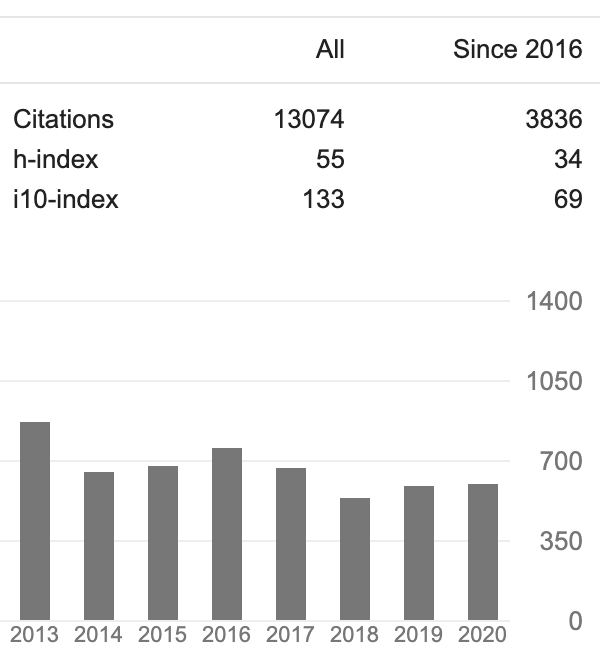
| 2021-01-8 10:42:57 |
CRD main achievements in 2019-2020

Figure 1. CRD papers citation by GOOGLE scholar
10 of CRD papaers has citation number above 50 reaching 700.
Journal publications in 2019-2020:
1. A.Chilingarian , S. Soghomonyan , Y. Khanikyanc , D. Pokhsraryan , On the origin of particle fluxes from thunderclouds, Astroparticle Physics 105 , 54(2019).
2. A.Chilingarian, Energetic radiation from thunderclouds: extended particle fluxes directed to Earth’s surface, Rendiconti Lincei. Scienze Fisiche e Naturali, doi.org/10.1007/s12210-018-0755-y, 2019.
3. A.Chilingarian, J.Knapp and M.Zazyan, Monitoring of the atmospheric electric field and cosmic-ray flux for the interpretation of results in high-energy astroparticle physics experiments, EPJ Web Conf., Volume 197, 2019, Atmospheric Monitoring for High-Energy Astroparticle Detectors (AtmoHEAD-2018), Article 03001.
4. K.Apresyan, A.Chilingaryan, A.Ghalumyan, V. Ghazaryan, Upgrade of YerPhI polarization LIDAR System for Investigation of the Influence of Static Electric Fields on the Elastic and Raman Backscattered Beams Polarization, The European Physical Journal Conferences 197(6):03005, DOI: 10.1051/epjconf/201919703005
K.A.Nicoll, R.G.Harriso,V.Barta et al.,A global atmospheric electricity monitoring network for climate and geophysical research, JASTP, 184, 18 (2019).
6. , , Catalog of 2017 Thunderstorm Ground Enhancement (TGE) events observed on Aragats, (2019) Nature Scientific Reports 9(1):6253, DOI: 10.1038/s41598-019-42786-7
7. A.Chilingarian, Reply to “Comment on ‘Long lasting low energy thunderstorm ground enhancements and possible Rn-222 daughter isotopes contamination, Phys. Rev. D 99, 108102 (2019)
8. A.Chilingarian, A. Avetisyan, G. Hovsepyan, T. Karapetyan, L. Kozliner, et al., Origin of the low-energy gamma ray flux of the long-lasting thunderstorm ground enhancements, Phys. Rev. D 99, 102002 (2019).
9. A.Chilingarian, Y. Khanikyants, V. A. Rakov, and S. Soghomonyan, Termination of thunderstorm-related bursts of energetic radiation and particles by inverted-polarity intracloud and hybrid lightning discharge, Atmospheric Research 233 104713, (2020).
10. Magic collaboration, Avery-high-energy component deep in the γ-ray burst afterglow, Nature 575 , 464–467, 20 November, 2019.
11. Magic collaboration, Observation of inverse Compton emission from a long γ-ray burst, Nature 575 , 459–463, 20 November, 2019.
12. A.Chilingarian, G. Hovsepyan, A. Elbekian, T. Karapetyan, L. Kozliner, H. Martoian, and B. Sargsyan, Origin of enhanced gamma radiation in thunderclouds, Physical review research, 1, 033167 (2019)
13. A.Chilingarian, G. Hovsepyan, E. Svechnikova, E. Mareev, Comment on “Measurement of the electrical properties of a thundercloud through muon imaging by the GRAPES-3 experiment’’, PRL 124, 019501 (2020)
14. Chilingarian, A. A. (2020), Understanding high-energy physics in Earth’s atmosphere, Eos, 101, https://doi.org/10.1029/2020EO138276. Published on 08 January 2020.
15. A.Chilingarian, G. Hovsepyan, T. Karapetyan, et al., Structure of thunderstorm ground enhancements, PRD 101, 122004 (2020).
16. A.Chilingarian, M. Dolgonosov, A. Kiselyov,Y. Khanikyants and S. Soghomonyan, Lightning observations using broadband VHF interferometer and electric field measurements, 2020 JINST 15 P07002
17. A.Chilingarian, G. Hovsepyan, G.Karapetyan, and M.Zazyan, Stopping muon effect and estimation of intracloud electric field, Astroparticle Physics 124 (2021) 102505.
18. Chilingarian,
A., Hovsepyan, G.,& Sargsyan, B. (2020). Circulation of Radon progeny in
the terrestrial atmosphere during thunderstorms. Geophysical Research
Letters,
47, e2020GL091155. https://doi. org/10.1029/2020GL091155.
19. Hunting, E. R., Matthews, J., de Arróyabe Hernáez, P. F., England, S. J., Kourtidis, K., Koh, K., et al. (2020). Challenges in coupling atmos- pheric electricity with biological systems. International Journal of Biometeorology. https://doi.org/10.1007/s00484-020-01960-7.
Ashot Chilingarian1, Tigran Karapetyan1, Mary Zazyan1, Gagik Hovsepyan1, Balabek Sargsyan1, Nina Nikolova2, Hristo Angelov2, Jaroslav Chum3, Rony Langer4, Analyzing atmospheric electric field by the European SEVAN network of particle detectors, NMBD symposium, July, 2020, Kiel University, Proceedings in press.CRD International collaborations
1. SEVAN Collaboration (Solar Physics, Atmospheric physics and Geophysics) includes Yerevan Physics Institute, Armenia, Institute of Nuclear Research and Nuclear Energy, Bulgaria, Ustav Jaderne Fyziky AV, Czech Rep., Ustav Experimentalnej Fyziky, Slovakia, Zagreb Observatory, Croatia.
2. NMDB Collaboration: Real-Time Database for high-resolution Neutron Monitor measurements; more than 40 European, Asian and American groups including CRD join efforts for research in solar physics and space weather.
3. GloCAEM project (global network for atmospheric electric field monitoring) – International project headed by the group of Redding Univ. UK, for atmospheric electricity research funded by NERC International Opportunities Fund grant NE/N013689/1.
4. Horizon 2020 COST Action: CA15211: “Atmospheric Electricity Network: coupling with the Earth System, climate and biological systems”
5. International Space Science Institute (ISSI) research group for "High-Energy Particles Sources and Powerful VHF Radiations in Electrically Active Atmosphere: Theoretical Models and Space Borne Instruments"
6. DESY – research and measurements of intracloud electric field for Cherenkov Telescope Array project.
7. Russian Scientific Foundation project 17-12-01439/2017, “Comprehensive research of high-energy particles sources and powerful VHF radiation in electrically active atmosphere based on ground-based measurements and satellite observations”, joint project of CRD with Institute of space Research of RAS, Moscow and Institute of Applied Physics of RAS, Nizhny Novgorod, headed by A.Chilingarian.
8. Work according to bilateral agreements with National Research Nuclear University MEPhI, and Scobeltcin Nuclear Physics institute, MSU, Moscow, Russia successfully continued.
9. MAGIC is European collaboration, operating is a system of two 17 meter Imaging Air Cherenkov Telescopes, located at the Observatorio Roque de los Muchachos at an altitude of 2200 meters on the Canary island of La Palma. MAGIC detects gamma rays in the very high energy regime between a few tens of GeV and tens of TeV.
10. Network of Solar Neutron Telescopes coordinated by Solar-terrestrial Environmental Laboratory, Nagoya University, Japan.
11. European Horizon 2020 CRREAT (Center of Cosmic Rays and Radiation Events in the Atmosphere) project, Nuclear Physics Institute of the CAS.
12. European Radiation Dosimetry Group (EURADOS).
13. World-Wide Lightning Location Network (WWLLN), University of Washington in Seatle.
